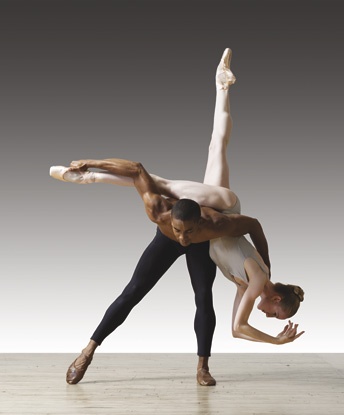Marc Macaranas is possibly River North Chicago Dance Company’s biggest fan. He is also a founding member and astute dancer with DanceWorks Chicago (who will be performing as part of the Chicago Dancing Festival throughout the day in Millennium Park on Saturday August 22, 2009).
Hanna Brictson is in her sixth season with RivNo, dynamic and unforgettable she will be performing Robert Battle’s Train with the company on Tuesday August 18th: New Voices at the Harris Theatre.
Marc and Hanna have both worked with master choreographer Robert Battle. Recently they sat down to discuss their shared experience.
Marc
River North’s style, to me, is very lush and expressive and makes use of a lot of port de bras; Robert Battle’s style is definitely not the same. How would you say that Train has evolved into the signature River North piece that it is now?
Hanna
I think the reason it’s evolved into a River North piece is because of the intent behind it. I find a lot of our pieces, at least for me, are emotionally connected, and that’s how I connect with the audience. So although this is on a completely different level, River North is not harsh usually, I’m able to connect to the audience with that same River North style. It’s not so much about the movement, it’s about the feeling you get from it – that makes it River North.
Marc
DanceWorks Chicago also has two of Robert’s pieces, Etude and Takademe, and doing his work is some of the most physically demanding dance that I’ve done; what energy do you have to channel to meet the physicality of the work or is there ever a moment you can just “phone it in”?
Hanna
Ok, definitely never phone it in – I can never do that. I think it’s a calmness I need to have, which sounds completely opposite, but I think to start from that, almost as if it was a silence - it’s a place to build from. Sometimes you get through it at that calm level and then your will power kicks in at the last minute.
Marc
So there’s two different kinds of energy? A physical energy and a mental stamina?
Hanna
I feel like the mental stamina is there from the beginning… when I start, the intensity is there in my mind, but physically I’m coming from a place where I know how to work things, and I’m coming from my knowledge as a dancer – how to use your body, how to work through things, and then at a certain point, I can’t use my knowledge, I can’t use my technique, I can’t use what people have taught me; all I can use, literally (I know it sounds corny), is how much power I have inside of me, and then it’s something I can’t even describe… it’s part of what makes me live, that strength that you need sometimes.
Marc
Specifically when performing Train or when you do any River North rep?
Hanna
Train has totally pulled out a different side of myself and a different side of my physical self, and I’ve never felt like I had to pull physically to get myself through something the way I have with Train, I can’t even compare it to anything else.
Marc
I think Etude and Train come from different vocabularies, but they definitely come from the same voice. What would you describe that voice to be, that intent?
Hanna
For some reason, the word “life” comes to mind. Robert didn’t give us a whole lot of direction on what the reason was behind what we were doing, so i’ve had to create that – for me it’s how I’ve gotten to this point in my life. I think that when I’m dancing Robert’s stuff, it’s that journey through those times you don’t want to talk about anymore but you let it out through those 3 minutes.
Marc
We both know that Robert works very quickly. Do you think the intensity of that short period speaks to the style of the movement? Do you think it would change if given a longer creative process?
Hanna
I think it probably would have changed if [the process] was longer. When he sets it so quickly, it never gets to that finished cleanliness that it’ll get because you rehearse it plenty of times, but from what you know of how it’s supposed to be, it always continues to stay in that raw stage… I feel like a lot choreographers want to start cleaning before they finish their works and he didn’t feel the need to that, he left it up to us. When you see it that quickly, and that movement is crazy fast, it’s going to be raw, it’s going to be whatever you make of it.
Marc
Do you think the piece has maintained the same integrity or purity as when Robert come to create it on you, or has it become something else to take on that River North quality?
Hanna
I think it evolves every time we do it, the nature of getting stronger at it and deciding what you want to make of it every time. I’ve never thought of it in a River North way… I keep it in a separate world, I just think of it as Train, I don’t even think of it as a piece of River North’s rep, I think of it as Robert Battle’s Train.


















